What is Marketing Automation? (+ Best Practices, Tips & More)
Pat Blakely
Updated by Tara Malone
Done right, marketing automation is like having a space-age supercomputer for handling your marketing grunt work.
In other words, automation makes running your business easier and more efficient.
Excited?
Here’s what you’ll learn today:
- How marketing automation can maximize efficiency and increase conversions
- The specific problems marketing automation solves
- Automation best practices that can help your business boom
- Plus, a lot more!
So if you’re ready to explore the magic of marketing automation, let’s dive right in!
What is Marketing Automation?
Marketing automation is the process of using technology to automate marketing tasks.
These tasks are often time-consuming, repetitive activities like:
- Email follow-ups
- Posting to social media
- Lead qualification
Although these tasks are menial, they’re still important. In fact, many of them are vital activities for engaging your target audience.
That said, by offloading these tasks to a marketing automation tool, you’re free to focus on the higher-order to-dos that have a greater impact on your business.
For example, improving your digital marketing strategy and creative problem-solving are higher priorities than a social media post or thank-you email.
The big idea is that marketing automation streamlines marketing and sales activities, helping enrich customer experience, boost conversions, and free up your time and energy for more important things.
What is a Marketing Automation Platform?
A marketing automation platform is software a marketer uses to create, manage, and perform automations.
These platforms run in the background, handling much of marketing busywork like lead generation, nurturing, and scoring tasks, as well as audience segmentation and analytics reporting.
That said, automation platforms aren’t all created alike.
Some focus on specific needs, while others offer a range of marketing automation features. Professional intelligent automation services can help brands effectively implement marketing automation technology.
Let’s take a quick look at some examples of popular marketing automation platforms.
Constant Contact
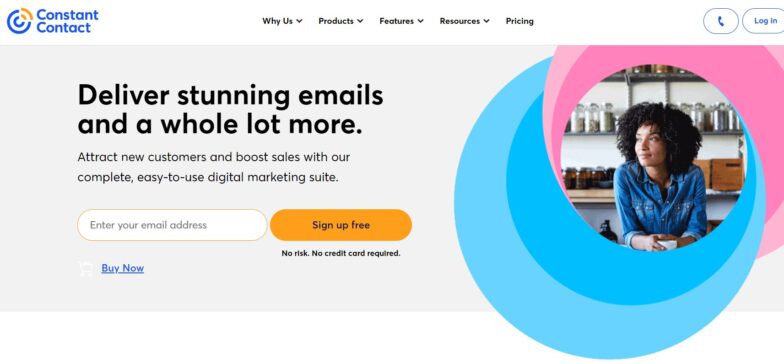
Constant Contact is a marketing automation platform that gives businesses the tools to connect with customers and grow their online presence. It offers a wide range of features including email marketing, social media marketing, and event marketing. The platform also lets you create and send email campaigns, manage your email list, and track results in real-time. It’s also very user-friendly, with a simple drag-and-drop interface and easy-to-use analytics. Constant Contact is best for small and medium-sized businesses, and you can sign up for a free trial to test out the platform.
HubSpot
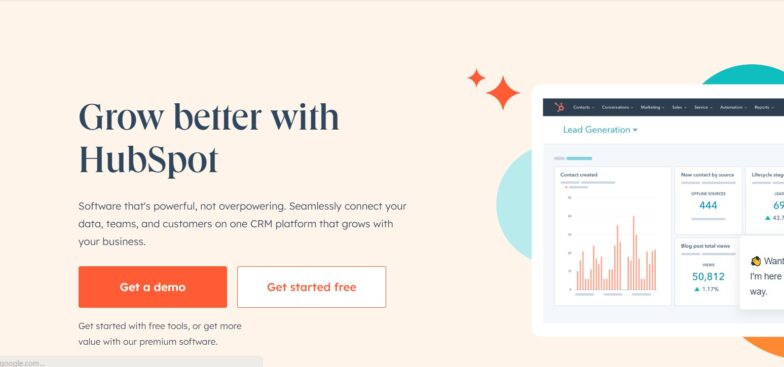
HubSpot is a hugely popular all-in-one marketing, sales, and service platform. The platform’s features include content management, SEO, social media, email marketing, lead generation, and analytics. With HubSpot, businesses can create and manage their website, blog, and landing pages, optimize their content for SEO, and create, send, and monitor email marketing campaigns. It also offers lead generation tools and has a CRM system for managing and tracking customer interactions. The platform is designed for businesses of all sizes, and it offers a free version for small businesses and paid plans for larger businesses.
Convert Kit
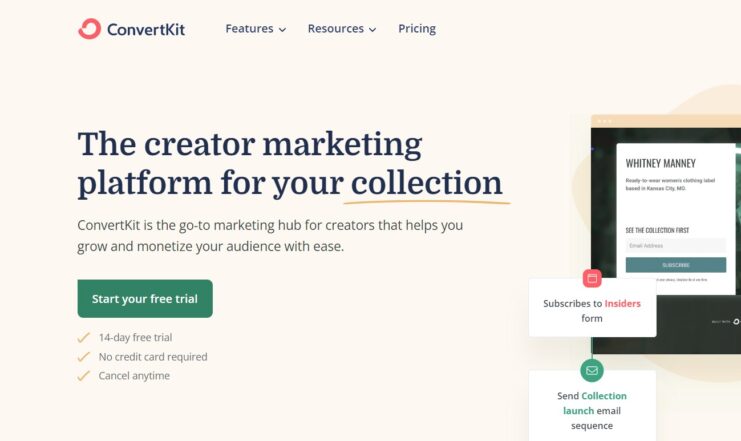
ConvertKit is a marketing automation platform geared towards professional bloggers, authors, and content creators. With ConvertKit, it’s easy to create and send professional-looking email campaigns, manage your email lists, and track your results. It also allows content creators to build and publish landing pages and forms that are optimized for high conversion rates, and set up automated email sequences. You can enroll in a free trial and then choose from several paid plans if you decide ConvertKit is the platform for you.
Keap
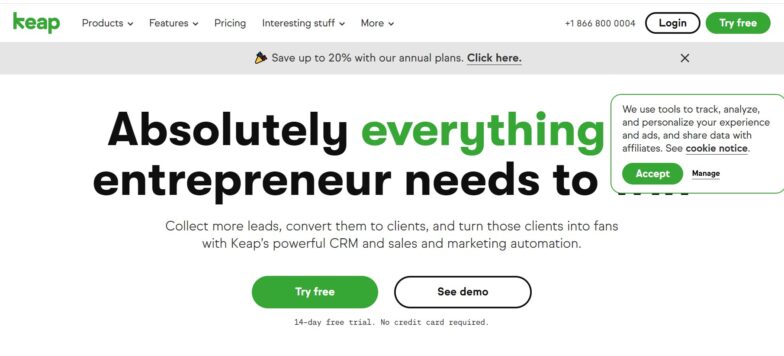
Keap is a CRM and marketing automation platform that helps small businesses automate and streamline their sales and marketing processes. The platform’s features include email marketing, lead capture, sales automation, and customer management. With Keap, businesses can create email campaigns and grow their email lists, as well as capture, score, and nurture leads with automated sequences. On top of this, Keap includes a CRM system and a range of sales automation tools. The platform is designed for small businesses and offers a free trial and a variety of paid plans.
Active Campaign
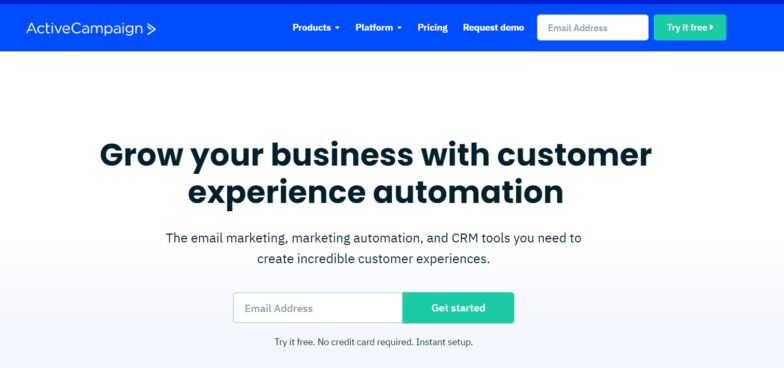
ActiveCampaign is a CRM and marketing automation platform that helps businesses streamline their sales and marketing processes. With ActiveCampaign, businesses can create email campaigns, manage and grow their email lists, and monitor their results in real-time. The platform also includes lots of sales automation tools and integrations with other popular business tools, like Shopify and Salesforce. It’s geared towards small and medium-sized businesses, and allows you to sign up for a free trial before investing in one of their paid plans.
This is just a small sampling of the marketing automation tools and platforms on the market today.
What Does Marketing Automation Do?
Now that you’ve got the gist of what marketing automation is and learned about some popular tools and platforms, let’s explore all the helpful things automation does for businesses.
1. Budget more time and resources for critical tasks
When you’re not spending time and resources on menial tasks, you can earmark more time and resources for critical tasks.
In other words, you’ll spend less money and get more important things done.
For example, automated chatbots can save you up to 30% on your customer service costs, and social media automation saves 6+ hours every week.
At scale, that’s a lot of extra time and money.
2. Personalize your marketing messages for higher conversions
90% of customers prefer working with companies that personalize customer service.
You see, personalization is a big deal when it comes to the customer experience.
Not only does personalization drive loyalty, but 42% of consumers are turned off by impersonal content marketing.
Even more alarming, 63% of consumers won’t even buy from companies with poor personalization.
Fortunately, with marketing automation, personalization is a breeze:
- Automatically segment your audience based on engagement and interest
- Nurture leads with relevant content delivered at the right time
- Make data-driven decisions to craft unique experiences for your customers, increasing engagement (and sales)
3. Increase sales while reducing overhead
The “holy grail of business” is anything that drives more sales while decreasing costs.
Enter marketing automation.
According to Nucleus Research, automation results in a 14.5% increase in sales productivity while achieving a 12.2% reduction in marketing overhead.
Not bad!
4. Scale your business easily and affordably
As your business begins to grow, you’ll experience two things:
- Happiness that your hard work is paying off.
- Panic as you wonder how you’re going to keep up.
The beauty of marketing automation is that it helps scale your business affordably, whether you gain 10 new customers or 10,000.
How Does Marketing Automation Work?

At a high-level, marketing automation collects data, segments your audience based on behaviors and interests, and lets you create personalized marketing campaigns to get your target audience to convert.
In a nutshell, you can break marketing automation into 6 steps:
Step 1: Collecting Customer Information
Information drives automation.
Every time your target audience engages with a piece of content, your marketing automation platform collects information.
For example, your target audience might engage with your content by:
- Opening an email
- Subscribing through a web form
- Making a purchase
- Downloading a freebie
- Clicking on an ad
Once this information is fed back to the automation platform, it creates a customer profile based on things like behaviors, interests, and demographics.
Step 2: Segmenting Your Audience
Without getting too complicated, segmentation means dividing your audience based on their interests, behaviors, actions, and the like.
In other words, segmentation means sorting your customer profiles into specific piles so you can identify and address their needs and pain points.
All marketing automation platforms provide some level of audience segmentation.
Step 3: Creating Personalized Marketing Content
Based on the information gathered in Step 1, you can start to create valuable, relevant content.
Let’s be clear: the marketer creates the content, whereas marketing automation collects the data needed to create personalized content.
This personalized content makes up the marketing messages in your campaigns, which you’ll deliver to your audience segments across different marketing channels like email, social media, and text.
Step 4: Planning Campaigns
Marketers plan campaigns and design the sequences that marketing automation software executes.
For example, let’s say a company has an abandoned cart nurturing sequence that automatically triggers when a customer adds an item to their cart and then clicks away from the site.
A marketer would have designed that sequence as part of a campaign in their marketing automation platform.
Step 5: Marketing Automation Executes the Plan
After you develop your marketing campaign, your automation software then takes over and runs your campaign from there.
Along the way, it also collects valuable data about your target audience and their individual customer journeys.
Step 6: Analyze Results and Tweak Campaigns
It’s crucial to continually track and analyze data provided by your automation software.
For example, you might look at where leads are most likely to convert in your customer journey or, just as important, where most leads are dropping off.
Use these results to tweak campaigns, optimize customer experience, and ultimately drive more conversions.
What Problems Can Marketing Automation Solve?
From chasing and nurturing leads to customer retention, modern marketing has many issues.
Now, marketing automation isn’t a silver bullet solution to all your marketing problems. But, with a host of features designed to make marketing easier – and the industry data to back it up – it might just be the next best thing.
Let’s explore some common problems marketing automation helps solve.
Tracking User Engagement
As you know by now, tracking how users engage with your content is essential.
To effectively market to your target audience, you’ll need to know critical data like:
- Open rates
- Click-through rates
- Pageviews
- Bounce rates
- Conversion rates
With this data, you’re not shooting in the dark with your marketing campaigns and can make informed decisions about what content is vibing with your target audience (and what isn’t).
Fortunately, marketing automation, by design, provides all these data points and more.
Generating and Converting Leads
91% of marketing professionals say generating high-quality leads is their top priority.
With marketing automation, it’s easier to generate and nurture leads with relevant content delivered across multiple channels.
And the results speak for themselves, with 77% of companies reporting higher conversions because of automated lead nurturing.
Customer Retention
Did you know it costs 5 times more to acquire new customers than to keep existing ones?
What’s more, you’re 60% – 70% more likely to sell to an existing customer, compared to a 5% – 20% chance of selling to a new one.
In other words, customer retention is a big deal that impacts your bottom line.
Marketing automation helps you retain customers by:
- Tracking and managing customer data
- Helping you create automated loyalty programs (to enhance customer experience)
- Cross-selling and upselling products and services
- Collecting customer feedback (which also helps refine customer experience)
Data Organization
As you scale, you’ll acquire an incredible amount of customer data.
Now, without organization and centralizing this information, you may lose leads, revenue, and probably even your mind, trying to keep track of everything.
Luckily, marketing automation sorts and stores all this data, and makes it accessible with just a few clicks.
How Does Marketing Automation Impact the Customer Journey?

Marketing automation impacts the customer journey in lots of different ways, and offers many benefits to both businesses and customers.
Here are a few of the most important ways marketing automation can enhance the customer journey.
- Creates a Personalized Experience: Marketing automation makes it easy to create personalized messages and content based on customer behavior and preferences, which provides a more tailored customer experience.
- Provides More Relevant Content: Automation tools can segment customers based on demographics, behavior, and other data points. This allows marketers to target specific groups with messages and offers that are actually relevant to them.
- Allows for Multi-Channel Communication: Marketing automation lets businesses communicate with customers across multiple channels, such as email, social media, and SMS. This helps businesses increase their reach and engagement, and provides extra opportunities to interact with customers, build engagement and loyalty with followers, and connect with new fans.
- Helps Nurture More Leads: Marketing automation can automate the process of nurturing leads by sending targeted, timed messages and content that helps move them through the sales funnel. It can also assign scores to leads based on their behavior and engagement, so you can prioritize which leads to pursue and when.
- Boosts Your Retargeting Efforts: Automation can retarget customers who have shown interest in a product or service, by providing them with relevant advertisements or special offers, which increases the chances of conversion.
What Are Some Marketing Automation Best Practices?
Now that you’ve survived marketing automation thus far, let’s cover some helpful best practices.
Plan Out Your Customer Journeys
So you’ve got some brand new marketing automation software, and you can’t wait to dive in.
But before you start chugging away, you should map out your customer journeys, detailing key stages from awareness to action.
Mapping out your customer journeys not only gives you the 30,000-foot view of your entire process, but your automated workflows are based on these journeys.
So, planning the journeys makes planning your workflows a heck of a lot easier – win-win!
Don’t Dial In Your Marketing Messages
You may have a sophisticated automated workflow, but your campaign performance will likely suffer without the right messaging to match.
Your marketing messages must be personalized and relevant at each stage of the customer journey. And this requires a deep understanding of your customers, their behaviors, and how they interact with your content.
Automation platforms do a lot of wonderful things.
But the actual crafting of meaningful marketing messages is all on you, so don’t gloss over this part.
Start Small and Work the Kinks Out
If you’re an automation newbie, it’s easy to underestimate the size of a marketing campaign.
Instead of tackling complex scenarios, start small. Look for simple activities that could benefit from automation.
For example, you could set up welcome emails for new subscribers or create simple sequences that send messages when certain events are triggered, like a birthday or a thank you message.
Once you’ve mastered the basics, gradually take on more complicated automation projects and learn the nuances of these activities.
Keep on Testing and Tweaking Your Campaigns
Marketing automation isn’t a set it and forget it solution.
Although some platforms have clever AI to help optimize marketing campaigns, you’ll still need to analyze the data to see what’s working and what isn’t.
So be sure to regularly check on your campaigns to see how they’re performing and then tweak your campaigns based on those results.
Marketing Automation FAQs
Before we wrap things up, let’s answer a few common FAQs about marketing automation.
1. What is an example of marketing automation?
A specific example of marketing automation is using an e-commerce platform to send abandoned cart emails to customers.
When a customer adds an item to their online shopping cart but does not complete the purchase, the e-commerce platform triggers an automated abandoned cart email that is sent to the customer. A lot of times, the email has a special promotion or discount to help motivate the customer to complete the purchase.
If this email doesn’t work, the e-commerce platform can then trigger a series of follow-up emails with different incentives like free shipping or limited-time offers.
2. What is the purpose of marketing automation?
The purpose of marketing automation is to streamline and automate repetitive marketing tasks in order to increase efficiency, improve the customer experience, and drive revenue growth.
By automating routine tasks such as email marketing campaigns, social media posts, and lead generation activities, businesses have extra time to focus on more strategic and high-priority activities while still staying connected to their customers.
3. How do I choose the best marketing automation solution for my business?
Choosing the best marketing automation solution for your business depends on a lot of different factors.
Here are a few things to keep in mind when selecting a marketing automation solution for your business:
- Understand what marketing activities you would like to automate.
- Be clear on what features and capabilities you need in a marketing automation solution.
- Look for solutions that have the features and capabilities you need, are within your budget, and have positive customer reviews.
- Try out your top choices with a free trial or test drive to see which one works best for you.
- Make sure the software integrates with other systems you’re using.
- Look for solutions with good customer support and training resources.
- Opt for solutions that have a flexible pricing model.
By considering these factors, you should be able to find a marketing automation solution that meets your business needs and helps you reach all your marketing goals.
Ready to Move Forward with Marketing Automation?
We’ve covered a lot of ground here today, and hopefully, you’ve learned a thing or two about what marketing automation is and how it can help your business boom.
If you’re ready to experience the mind-blowing world of automated marketing first-hand, we encourage you to investigate your options and from there select a few platforms to test out.
Actually testing a few potential marketing automation platforms is by far the best way to discover which one is right for your business.
So what are you waiting for?
Go ahead and find your winning marketing automation platform today!